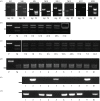Mitochondrial uniparental inheritance achieved after fertilization challenges the nuclear-cytoplasmic conflict hypothesis for anisogamy evolution
- PMID: 37752851
- PMCID: PMC10523090
- DOI: 10.1098/rsbl.2023.0352
Mitochondrial uniparental inheritance achieved after fertilization challenges the nuclear-cytoplasmic conflict hypothesis for anisogamy evolution
Abstract
In eukaryotes, a fundamental phenomenon underlying sexual selection is the evolution of gamete size dimorphism between the sexes (anisogamy) from an ancestral gametic system with gametes of the same size in both mating types (isogamy). The nuclear-cytoplasmic conflict hypothesis has been one of the major theoretical hypotheses for the evolution of anisogamy. It proposes that anisogamy evolved as an adaptation for preventing nuclear-cytoplasmic conflict by minimizing male gamete size to inherit organelles uniparentally. In ulvophycean green algae, biparental inheritance of organelles is observed in isogamous species, as the hypothesis assumes. So we tested the hypothesis by examining whether cytoplasmic inheritance is biparental in Monostroma angicava, a slightly anisogamous ulvophycean that produces large male gametes. We tracked the fates of mitochondria in intraspecific crosses with PCR-RFLP markers. We confirmed that mitochondria are maternally inherited. However, paternal mitochondria enter the zygote, where their DNA can be detected for over 14 days. This indicates that uniparental inheritance is enforced by eliminating paternal mitochondrial DNA in the zygote, rather than by decreasing male gamete size to the minimum. Thus, uniparental cytoplasmic inheritance is achieved by an entirely different mechanism, and is unlikely to drive the evolution of anisogamy in ulvophyceans.
Keywords: anisogamy; isogamy; organelle inheritance; ulvophycean green algae.
Conflict of interest statement
We declare we have no competing interests.
Figures


Similar articles
-
Evolutionary trajectories explain the diversified evolution of isogamy and anisogamy in marine green algae.Proc Natl Acad Sci U S A. 2012 Aug 21;109(34):13692-7. doi: 10.1073/pnas.1203495109. Epub 2012 Aug 6. Proc Natl Acad Sci U S A. 2012. PMID: 22869736 Free PMC article.
-
Cytoplasmic inheritance of mitochondria and chloroplasts in the anisogamous brown alga Mutimo cylindricus (Phaeophyceae).Protoplasma. 2021 Jan;258(1):19-32. doi: 10.1007/s00709-020-01540-x. Epub 2020 Aug 29. Protoplasma. 2021. PMID: 32862312
-
Evolution of the Two Sexes under Internal Fertilization and Alternative Evolutionary Pathways.Am Nat. 2019 May;193(5):702-716. doi: 10.1086/702588. Epub 2019 Mar 18. Am Nat. 2019. PMID: 31002575
-
Cytoplasmic inheritance in green algae: patterns, mechanisms and relation to sex type.J Plant Res. 2010 Mar;123(2):171-84. doi: 10.1007/s10265-010-0309-6. Epub 2010 Jan 30. J Plant Res. 2010. PMID: 20112126 Review.
-
Cytoplasmic inheritance of organelles in brown algae.J Plant Res. 2010 Mar;123(2):185-92. doi: 10.1007/s10265-010-0313-x. Epub 2010 Feb 10. J Plant Res. 2010. PMID: 20145971 Review.
Cited by
-
A nuclear-encoded endonuclease governs the paternal transmission of mitochondria in Cucumis plants.Nat Commun. 2025 May 8;16(1):4266. doi: 10.1038/s41467-025-59568-7. Nat Commun. 2025. PMID: 40341554 Free PMC article.
References
-
- Cox PA, Sethian JA. 1985. Gamete motion, search, and the evolution of anisogamy, oogamy, and chemotaxis. Am. Nat. 125, 74-101. (10.1086/284329) - DOI
-
- Hoekstra RF. 1987. The evolution of sexes. In The evolution of sex and its consequences (ed. Stearns SC), pp. 59-91. Basel, Switzerland: Birkhäuser-Verlag.
-
- Maynard Smith J, Szathmáry E. 1995. The major transitions in evolution. Oxford, UK: Freeman.
Publication types
MeSH terms
Substances
Associated data
LinkOut - more resources
Full Text Sources

